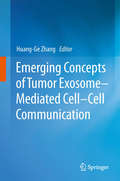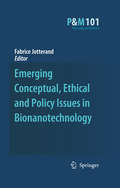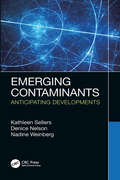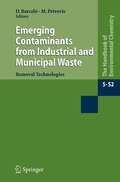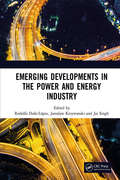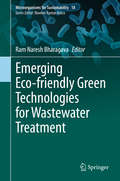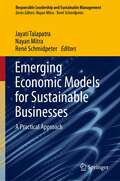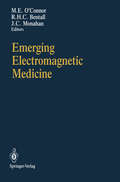- Table View
- List View
Emerging Concepts of Tumor Exosome–Mediated Cell-Cell Communication
by Huang-Ge ZhangIn multicellular organisms, communication between cells involves secretion of proteins that bind to receptors on neighboring cells. While this has been well documented, another mode of intercellular communication has recently become the subject of increasing interest: the release of exosomes. In cancer, tumor exosomes are involved in various aspects of pathogenesis, including proliferation, immunosuppression, and metastasis. Given the ability of exosomes to export unneeded endogenous molecules from cells, these structures hold great potential as anticancer therapeutic agents. They are also being studied as prognostic markers for cancer.
Emerging Concepts Targeting Immune Checkpoints in Cancer and Autoimmunity (Current Topics in Microbiology and Immunology #410)
by Akihiko YoshimuraThis volume reviews the current state of research on immune checkpoints and offers novel concepts. It discusses the two most important immune checkpoints: T lymphocyte-associated antigen-4 (CTLA-4) and programmed cell death-1 (PD-1). It shows that antagonistic antibodies against these two molecules are highly effective in the treatment of various cancers and that PD-1 and CTLA-4 have been linked to the suppression of T-cell receptor signaling and co-stimulatory molecules. Further, the volume examines other agents, a number of cells, receptors and signaling molecules, that are also involved in the regulation of T-cell activation and extends the concept of immune checkpoints to “molecules and cells that negatively regulate T-cell activation”. Playing essential roles in immune homeostasis, they could offer new targets for cancer immunotherapy, and for the therapy of autoimmune diseases. Written by internationally respected scientists, this book will appeal to basic scientists, clinicians, drug development researchers, and advanced students alike.
Emerging Conceptual, Ethical and Policy Issues in Bionanotechnology (Philosophy and Medicine #101)
by Fabrice JotterandNanobiotechnology is the convergence of existing and new biotechnology with the 1 ability to manipulate matter at or near the molecular level. This ability to manipulate matter on a scale of 100 nanometers (nm) or less is what constitutes the nanotechnology revolution occurring today, the potentially vast economic and social implications of which are yet to be fully understood (Royal Society, 2004). The most immediate way to understand the implications of nanobiotechnology for ethics is to consider the real life concerns of communities that are mobilizing within civil society. The conflicts and ethical debates surrounding nanotechnology will, almost by definition, emerge on the fault lines between different civil society actors, researchers and financial interests associated with nanobiotechnology, as well as (potentially) government regulators. These fault lines are all reflected within the concerns (as expressed d- cursively) of the communities mobilizing. This chapter will explore converging d- courses regarding converging technologies. Converging Technologies (CT) are already a familiar theme in the next gene- tion of biotechnology, nanotechnology, pharmacogenomics and proteomics research 2 and development. Nanobiotechnology means that previously separate disciplines (IT, physics, chemistry, and biology) are merging and converging to create new applications and even new life forms through converged technological platforms. Schummer (2004), and Glimell and Fogelberg (2003, p. 43), note the predominance of interdisciplinarity as a core theme of nano-discourse.
The Emerging Consensus in Social Systems Theory
by Kenneth C. BauschIn The Emerging Consensus of Social Systems Theory Bausch summarizes the works of over 30 major systemic theorists. He then goes on to show the converging areas of consensus among these out-standing thinkers. Bausch categorizes the social aspects of current systemic thinking as falling into five broadly thematic areas: designing social systems, the structure of the social world, communication, cognition and epistemology. These five areas are foundational for a theoretic and practical systemic synthesis. They were topics of contention in a historic debate between Habermas and Luhmann in the early 1970's. They continue to be contentious topics within the study of social philosophy. Since the 1970's, systemic thinking has taken great strides in the areas of mathematics, physics, biology, psychology, and sociology. This book presents a spectrum of those theoretical advances. It synthesizes what various strains of contemporary systems science have to say about social processes and assesses the quality of the resulting integrated explanations. Bausch gives a detailed study of the works of many present-day systems theorists, both in general terms, and with regard to social processes. He then creates and validates integrated representations of their thoughts with respect to his own thematic classifications. He provides a background of systemic thinking from an historical context, as well as detailed studies of developments in sociological, cognitive and evolutionary theory. This book presents a coherent, dynamic model of a self-organizing world. It proposes a creative and ethical method of decision-making and design. It makes explicit the relations between structure and process in the realms of knowledge and being. The new methodology that evolves in this book allows us to deal with enormous complexity, and to relate ideas so as to draw out previously unsuspected conclusions and syntheses. Therein lies the elegance and utility of this model.
Emerging Contaminants: Anticipating Developments
by Kathleen Sellers Denice K. Nelson Nadine WeinbergEmerging Contaminants: Anticipating Developments examines the factors that have led "new" environmental contaminants to emerge in the past and combines the lessons learned to anticipate potential new developments. The analyses described in this book originate in multiple disciplines: the science of toxicology; environmental law and regulation; the field of product stewardship; and the social science which explains why ideas take hold. Over a dozen case studies of contaminants that emerged as environmental issues over the last hundred years illustrate crucial points. The results of the analyses in this book support a step-by-step method to assess the potential for a contaminant to emerge, and a framework to apply those conclusions to managing site liabilities. Features: Describes an unprecedented understanding of why contaminants emerge as issues, based on a multidisciplinary analysis Makes abstract concepts tangible, basing analyses on data and illustrating key points with case studies Enables readers to anticipate and prepare to manage future challenges associated with emerging chemicals Presents an analytical framework for companies to assess and manage business risks Written for regulators, policymakers, industry professionals with responsibility for contaminated site management, as well as attorneys, and consultants, this book provides a framework for anticipating the emergence of new contaminants so that the risks–whether to human health and the environment or to a business–can be anticipated and appropriately managed.
Emerging Contaminants: Anticipating Developments
by Kathleen Sellers Denice K. Nelson Nadine WeinbergEmerging Contaminants: Anticipating Developments examines the factors that have led "new" environmental contaminants to emerge in the past and combines the lessons learned to anticipate potential new developments. The analyses described in this book originate in multiple disciplines: the science of toxicology; environmental law and regulation; the field of product stewardship; and the social science which explains why ideas take hold. Over a dozen case studies of contaminants that emerged as environmental issues over the last hundred years illustrate crucial points. The results of the analyses in this book support a step-by-step method to assess the potential for a contaminant to emerge, and a framework to apply those conclusions to managing site liabilities. Features: Describes an unprecedented understanding of why contaminants emerge as issues, based on a multidisciplinary analysis Makes abstract concepts tangible, basing analyses on data and illustrating key points with case studies Enables readers to anticipate and prepare to manage future challenges associated with emerging chemicals Presents an analytical framework for companies to assess and manage business risks Written for regulators, policymakers, industry professionals with responsibility for contaminated site management, as well as attorneys, and consultants, this book provides a framework for anticipating the emergence of new contaminants so that the risks–whether to human health and the environment or to a business–can be anticipated and appropriately managed.
Emerging Contaminants from Industrial and Municipal Waste: Removal technologies (The Handbook of Environmental Chemistry #5 / 5S / 5S/2)
by Damià Barceló Mira PetrovicThis book focuses on innovative treatment technologies for the elimination of emerging contaminants in wastewater and drinking water treatment processes. The book also discusses sources and occurrence of emerging contaminants in municipal and industrial waste, giving an overview of state-of-the-art analytical methods for their identification. Further important aspects covered include the acute and chronic effects and overall impact of emerging contaminants on the environment.
Emerging Contaminants from Industrial and Municipal Waste: Occurrence, Analysis and Effects (The Handbook of Environmental Chemistry #5 / 5S / 5S/1)
by Damià Barceló Mira PetrovicThis book focuses on innovative treatment technologies for the elimination of emerging contaminants in wastewater and drinking water treatment processes. The book also discusses sources and occurrence of emerging contaminants in municipal and industrial waste, giving an overview of state-of-the-art analytical methods for their identification. Further important aspects covered include the acute and chronic effects and overall impact of emerging contaminants on the environment.
Emerging Contaminants Handbook
by Caitlin H. Bell Margaret Gentile Erica Kalve Ian Ross John Horst Suthan SuthersanThe term "emerging contaminants" and its multiple variants has come to refer to unregulated compounds discovered in the environment that are also found to represent a potential threat to human and ecological receptors. Such contaminants create unique and considerable challenges as the push to address them typically outpaces the understanding of their toxicity, their need for regulation, their occurrence, and techniques for treating the environmental media they affect. With these challenges in mind, this handbook serves as a primer regarding the topic of emerging contaminants, with current and practical information to help support the goal of protection where they are encountered. Features Explores the definition, identification, and life cycle of emerging contaminants. Reviews current information on sources, toxicology, regulation, and new tools for characterization and treatment of: 1,4-Dioxane (mature in its emerging contaminant life cycle) Per- and polyfluoroalkyl substances (PFASs; a newer group of emerging contaminant) Hexavalent chromium (former emerging contaminant with evolving science) 1,2,3-Trichloropropane (progressing in its emerging contaminant life cycle) Provides thoughts on opportunities in managing emerging contaminants to help balance uncertainty, compress life cycle, and optimize outcomes.
Emerging Contaminants Handbook
by Caitlin H. Bell Margaret Gentile Erica Kalve Ian Ross John Horst Suthan SuthersanThe term "emerging contaminants" and its multiple variants has come to refer to unregulated compounds discovered in the environment that are also found to represent a potential threat to human and ecological receptors. Such contaminants create unique and considerable challenges as the push to address them typically outpaces the understanding of their toxicity, their need for regulation, their occurrence, and techniques for treating the environmental media they affect. With these challenges in mind, this handbook serves as a primer regarding the topic of emerging contaminants, with current and practical information to help support the goal of protection where they are encountered. Features Explores the definition, identification, and life cycle of emerging contaminants. Reviews current information on sources, toxicology, regulation, and new tools for characterization and treatment of: 1,4-Dioxane (mature in its emerging contaminant life cycle) Per- and polyfluoroalkyl substances (PFASs; a newer group of emerging contaminant) Hexavalent chromium (former emerging contaminant with evolving science) 1,2,3-Trichloropropane (progressing in its emerging contaminant life cycle) Provides thoughts on opportunities in managing emerging contaminants to help balance uncertainty, compress life cycle, and optimize outcomes.
Emerging Contaminants in River Ecosystems: Occurrence and Effects Under Multiple Stress Conditions (The Handbook of Environmental Chemistry #46)
by Mira Petrovic Sergi Sabater Arturo Elosegi Damià BarcelóThis volume offers an overview of the occurrence of emerging organic contaminants in Mediterranean rivers and their relevance to their chemical and ecological quality under water scarcity. With chapters covering the effects under multiple stress conditions of pharmaceuticals, polar pesticides, personal care products, and industrial chemicals, the observations presented can be applicable to other parts of the world where water scarcity is an issue . It is of interest to environmental chemists, ecologists, environmental engineers, and ecotoxicologists, as well as water managers and decision-makers.
Emerging Contaminants Vol. 1: Occurrence and Impact (Environmental Chemistry for a Sustainable World #65)
by Nadia Morin-Crini Eric Lichtfouse Grégorio CriniEmerging contaminants are chemical and biological agents for which there is growing concern about their potential health and environmental effects. The threat lies in the fact that the sources, fate and toxicology of most of these compounds have not yet been studied. Emerging contaminants, therefore, include a large number of both recently discovered and well-known compounds such as rare earth elements, viruses, bacteria, nanomaterials, microplastics, pharmaceuticals, endocrine disruptors, hormones, personal care products, cosmetics, pesticides, surfactants and industrial chemicals. Emerging contaminants have been found in many daily products, and some of them accumulate in the food chain. Correlations have been observed between aquatic pollution by emerging contaminants and discharges from wastewater treatment plants. Most actual remediation methods are not effective at removing emerging contaminants. This first volume presents comprehensive knowledge on emerging contaminants with a focus on analysis, toxicity, antibiotic resistance and human health.
Emerging Contaminants Vol. 2: Remediation (Environmental Chemistry for a Sustainable World #66)
by Nadia Morin-Crini Eric Lichtfouse Grégorio CriniEmerging contaminants are chemical and biological agents for which there is growing concern about their potential health and environmental effects. The threat lies in the fact that the sources, fate and toxicology of most of these compounds have not yet been studied. Emerging contaminants, therefore, include a large number of both recently discovered and well-known compounds such as rare earth elements, viruses, bacteria, nanomaterials, microplastics, pharmaceuticals, endocrine disruptors, hormones, personal care products, cosmetics, pesticides, surfactants and industrial chemicals. Emerging contaminants have been found in many daily products, and some of them accumulate in the food chain. Correlations have been observed between aquatic pollution by emerging contaminants and discharges from wastewater treatment plants. Most actual remediation methods are not effective at removing emerging contaminants. This second volume presents comprehensive knowledge on emerging contaminants with a focus on remediation.
Emerging Development of Agriculture in East Africa: Markets, Soil, and Innovations
by Takashi Yamano, Keijiro Otsuka and Frank PlaceEmerging Development of Agriculture in East Africa offers case studies that find promise in many new innovations. Farmers in Uganda have quickly learned the management of NERICA rice (a new upland rice variety), which is being disseminated in a limited way in the region. Also in Uganda, farmers living in more remote areas have improved access to markets due to the expansion of mobile phones. In Kenya, improved milk marketing systems have increased efficiency and led to tangible increases in the adoption of dairy production technologies. And the adoption of intensive dairy production systems in Kenya and Uganda are providing significant amounts of manure and positively impacting yields of maize and banana.
Emerging Developments in the Power and Energy Industry: Proceedings of the 11th Asia-Pacific Power and Energy Engineering Conference (APPEEC 2019), April 19-21, 2019, Xiamen, China
by Rodolfo Dufo-López Jaroslaw Krzywanski Jai SinghPower and Energy Engineering are important and pressing topics globally, covering issues such as shifting paradigms of energy generation and consumption, intelligent grids, green energy and environmental protection. The 11th Asia-Pacific Power and Energy Engineering Conference (APPEEC 2019) was held in Xiamen, China from April 19 to 21, 2019. APPEEC has been an annual conference since 2009 and has been successfully held in Wuhan (2009 & 2011), Chengdu (2010 & 2017), Shanghai (2012 & 2014), Beijing (2013 & 2015), Suzhou (2016) and Guilin (2018), China. The objective of APPEEC 2019 was to provide scientific and professional interactions for the advancement of the fields of power and energy engineering. APPEEC 2019 facilitated the exchange of insights and innovations between industry and academia. A group of excellent speakers have delivered keynote speeches on emerging technologies in the field of power and energy engineering. Attendees were given the opportunity to give oral and poster presentations and to interface with invited experts.
Emerging Devices for Low-Power and High-Performance Nanosystems: Physics, Novel Functions, and Data Processing (Pan Stanford Series on Intelligent Nanosystems)
by Simon DeleonibusThe history of information and communications technologies (ICT) has been paved by both evolutive paths and challenging alternatives, so-called emerging devices and architectures. Their introduction poses the issues of state variable definition, information processing, and process integration in 2D, above IC, and in 3D. This book reviews the capabilities of integrated nanosystems to match low power and high performance either by hybrid and heterogeneous CMOS in 2D/3D or by emerging devices for alternative sensing, actuating, data storage, and processing. The choice of future ICTs will need to take into account not only their energy efficiency but also their sustainability in the global ecosystem.
Emerging Devices for Low-Power and High-Performance Nanosystems: Physics, Novel Functions, and Data Processing (Pan Stanford Series on Intelligent Nanosystems)
by Simon DeleonibusThe history of information and communications technologies (ICT) has been paved by both evolutive paths and challenging alternatives, so-called emerging devices and architectures. Their introduction poses the issues of state variable definition, information processing, and process integration in 2D, above IC, and in 3D. This book reviews the capabilities of integrated nanosystems to match low power and high performance either by hybrid and heterogeneous CMOS in 2D/3D or by emerging devices for alternative sensing, actuating, data storage, and processing. The choice of future ICTs will need to take into account not only their energy efficiency but also their sustainability in the global ecosystem.
Emerging Dimensions of Technology Management
by K. B. Akhilesh Technology is the key driver of business. May it be airport, ICT , smart governance, manufacturing or plantations. Technology management opens up opportunities for the business and help achieve leadership positions. This collection of papers provides a glimpse of issues faced in different sectors. These papers also should inspire more researchers to expand the scope of the subject itself.
Emerging Dynamics: Science, Energy, Society and Values
by Loucas G. ChristophorouEmerging Dynamics: Science, Energy, Society and Values focuses on the impact of science, science-based technology and scientific values on present-day humanity and its future. The book advocates for a science willing to accommodate both human values and scientific facts. The four main subjects focused on throughout the text are:The overwhelming impact of modern science and science-based technology on virtually every aspect of human lifeHuman values and their significance for science and societyThe need for mutual accommodation between scientific values and the traditional values of societyThe fundamental role of energy for civilization and society.The book cuts across scientific disciplines and looks at modern civilization through the knowledge provided by the physical, chemical, biomedical and other branches of natural science. The book is unique in its holistic approach, combining knowledge acquired by deduction, reduction-induction, and experimental scientific methods with knowledge acquired through history, philosophy, the arts, faith and cultural traditions. Modern civilization’s most distinct characteristics are due to science, science-based technology and energy. The role of energy in the sustainability of civilization and the impact of biomedical science on man are especially emphasized throughout this timely book, making a case for a hopeful future based on both science and values. A science guided in its applications by human values and a value system cognizant of the facts of science and willing to accommodate them
Emerging Eco-friendly Green Technologies for Wastewater Treatment (Microorganisms for Sustainability #18)
by Ram Naresh BharagavaAs we know, rapid industrialization is a serious concern in the context of a healthy environment and public health due to the generation of huge volumes of toxic wastewater. Although various physico-chemical and biological approaches are available for the treatment of this wastewater, many of them are not effective. Now, there a number of emerging ecofriendly, cost-effective approaches utilizing microorganisms (bacterial/fungi/algae), green plants or their enzymes, and constructed wetland treatment systems in the treatment of wastewaters containing pollutants such as endocrine disrupting chemicals, toxic metals, pesticides, dyes, petroleum hydrocarbons and phenolic compounds. This book provides a much-needed, comprehensive overview of the various types of wastewater and their ecotoxicological effects on the environment, humans, animals and plants as well as various emerging and eco-friendly approaches for their treatment. It provides insights into the ecological problems and challenges in the treatment and management of wastewaters generated by various sources.
Emerging Economic Models for Sustainable Businesses: A Practical Approach (Responsible Leadership and Sustainable Management)
by René Schmidpeter Nayan Mitra Jayati TalapatraThe book discusses new and emerging economic models, that respond to 'Pulling' and 'Pushing' forces. Today we are poised at an interesting juncture, with favourable conditions making it easier to be a sustainable organization acting as a ‘Pulling’ Force and the climate crisis, rise in social-economic equities thereby ‘Pushing’ for urgent action. The book analyses economic models that look at value propositions, creation and capture with ‘People, Planet and Profit’ deeply embedded in each stage of the value chain. The contributions bring out the interplay between new standards, evaluation frameworks, technology innovation and other emerging tools to show how they create a sustainable business. For this, they lean on learnings from successful sustainable businesses. Business leaders will find that this book provides deep insights on improving their existing sustainable practices, and speeding up the transition from linear to circular, narrow stakeholder driven to community driven. For prospective entrepreneurs the book provides the nudge needed to start up a sustainable enterprise. Students and researchers can benefit from real-life examples of how sustainable transformations unfold.The book thus creates an easy guide for those willing to make the transition to sustainability, start a sustainable business and most of all, to motivate those who may not yet be convinced about the long-term sense of taking care of our people and our earth.
Emerging Electromagnetic Medicine
by Mary E. O'Connor Richard H. C. Bentall John C. MonahanEmerging Electromagnetic Medicine presents the latest research findings in the field of electromagnetic radiation. The book discusses the research of current active researchers in terms of synthesizing and sharing their ideas on the use of electromagnetic fields in diagnostic and therapeutic medicine, now and in the future, including the benefits and risks involved. The book consists of three parts prefaced by a brief historic perspective. Section I describes the theoretical concerns and actual mechanisms involved; Section II covers current preclinical studies, performed in vivo and in vitro, concerning the biological action of the electromagnetic radiation; and Section III reports on actual clinical applications of electromagnetic therapy and also the current machinery used to do so.
Emerging Electromagnetic Technologies for Brain Diseases Diagnostics, Monitoring and Therapy
by Lorenzo Crocco Irene Karanasiou Michael L James Raquel Cruz ConceiçãoThis timely book presents innovative technologies for use in the diagnosis, monitoring, and treatment of brain disease. These technologies offer exciting possibilities in the medical field owing to their low-cost, portability and safety. The authors address cerebrovascular diseases such as stroke, ischemia, haemorrhage, and vasospasm, these diseases having an ever-increasing societal relevance due to the global ageing population. The authors describe the potential of novel techniques such as microwave imaging and present innovative modalities for treatment of brain tumours using electromagnetic fields and nano-composites, as well as for monitoring brain temperature during surgery. Finally, Emerging Electromagnetic Technologies for Brain Diseases Diagnostics, Monitoring and Therapy addresses the perspectives which arise from multi-modal multi-spectral EM modalities, which make a synergic use of the different portions of the electromagnetic spectrum. This text will be of interest to readers from various different areas, given the fundamental interdisciplinarity of the subject matter. This includes researchers or practitioners in the field of electrical engineering, applied physicists, and applied mathematicians working on imaging applications for biomedical and electromagnetic technologies. Neurologists and radiologists may also find this book of interest, as may graduate students in these areas.
Emerging Energetic Materials: Synthesis, Physicochemical, And Detonation Properties
by Dabir S. Viswanath Tushar K. Ghosh Veera M. BodduThis book summarizes science and technology of a new generation of high-energy andinsensitive explosives. The objective is to provide professionals with comprehensiveinformation on the synthesis and the physicochemical and detonation properties ofthe explosives. Potential technologies applicable for treatment of contaminated wastestreams from manufacturing facilities and environmental matrices are also be included.This book provides the reader an insight into the depth and breadth of theoreticaland empirical models and experimental techniques currently being developed in thefield of energetic materials. It presents the latest research by DoD engineers andscientists, and some of DoD’s academic and industrial researcher partners. The topicsexplored and the simulations developed or modified for the purposes of energetics mayfind application in other closely related fields, such as the pharmaceutical industry.One of the key features of the book is the treatment of wastewaters generated duringmanufacturing of these energetic materials.
Emerging Energy Materials: Applications and Challenges (Series in Materials Science and Engineering)
by Govind B. Nair H. Nagabhushana Nirupama S. Dhoble Sanjay J. DhobleEmerging Energy Materials: Applications and Challenges guides the reader through materials used in progressive energy systems.It tackles their use in energy storage across solar, bio, geothermal, wind, fossil, hydrogen, nuclear, and thermal energy. Specific chapters are dedicated to energy reaping systems currently in development. This book contributes to the current literature by highlighting concerns that are frequently overlooked in energy materials textbooks. Awareness of these challenges and contemplation of possible solutions is critical for advancing the field of energy material technologies.Key features: Provides up-to-date information on the synthesis, characterization, and a range of applications using various physical and chemical methods Presents the latest advances in future energy materials and technologies subjected to specific applications Includes applied illustrations, references, and advances in order to explain the challenges and trade-offs in the field of energy material research and development Includes coverage of solar cell and photovoltaic, hydro power, nuclear energy, fuel cell, battery electrode, supercapacitor and hydrogen storage applications This book is a timely reference for researchers looking to improve their understanding of emerging energy materials, as well as postgraduate students considering a career within materials science, renewable energy and materials chemistry.
